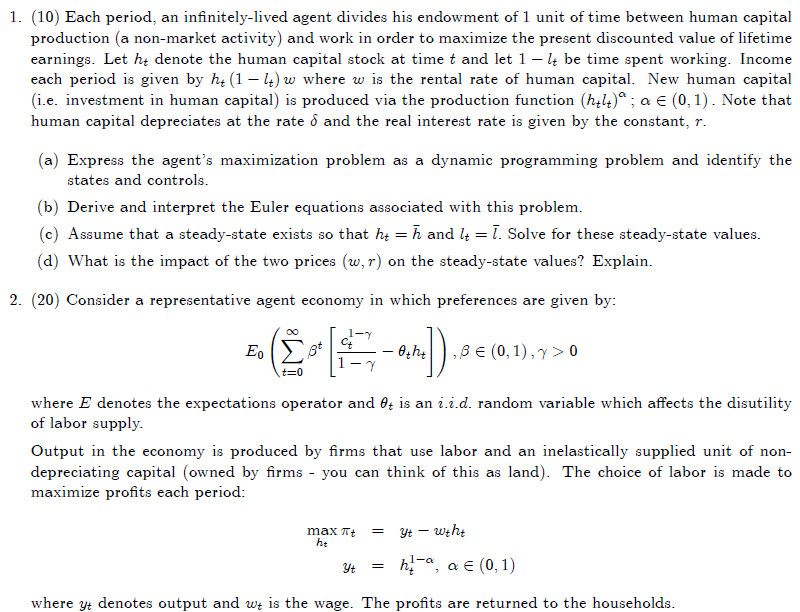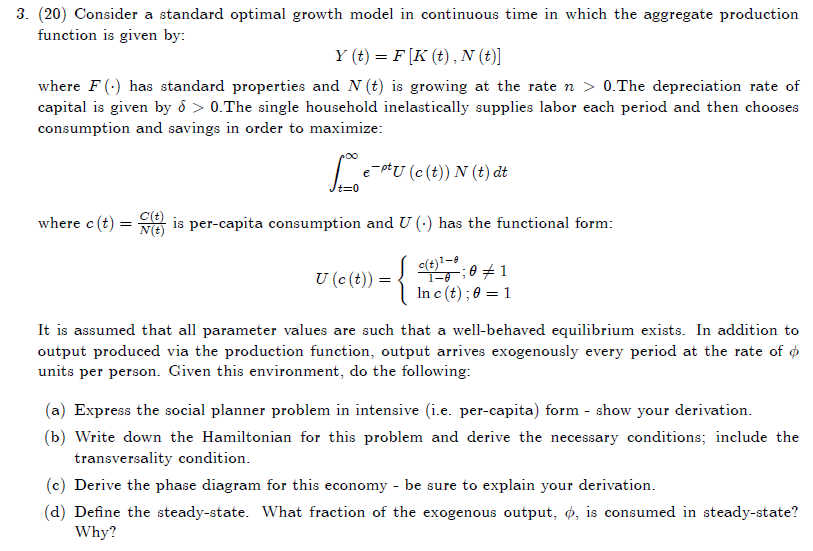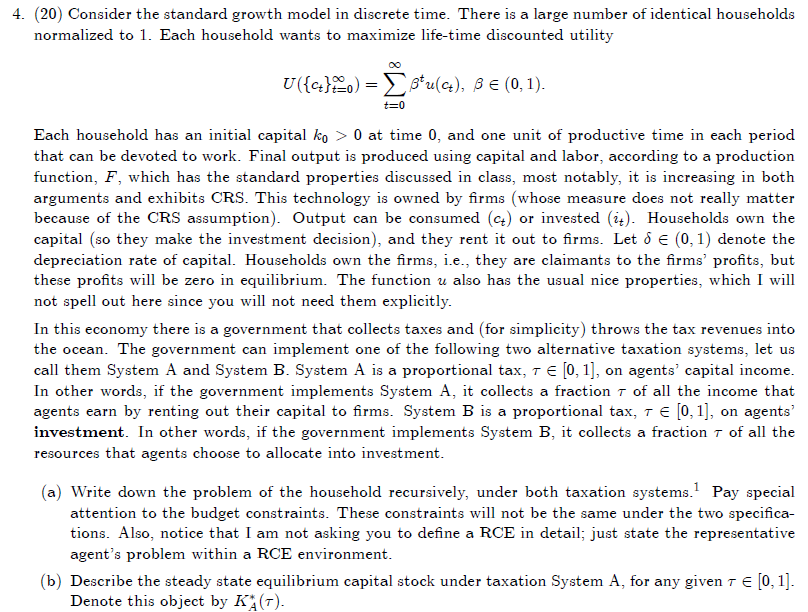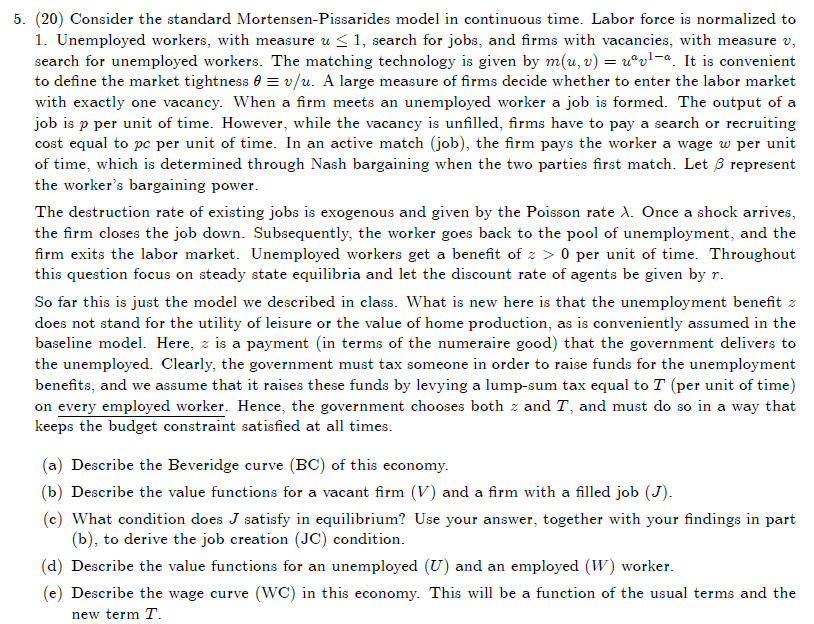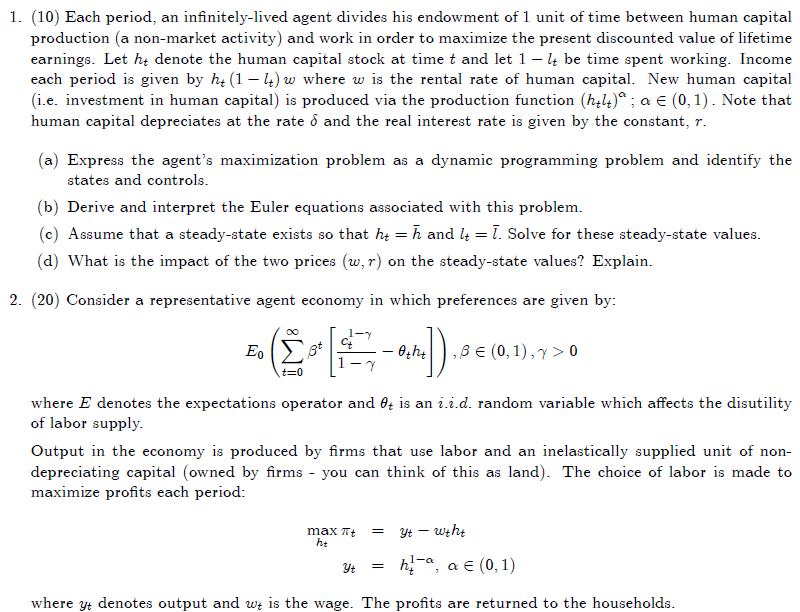

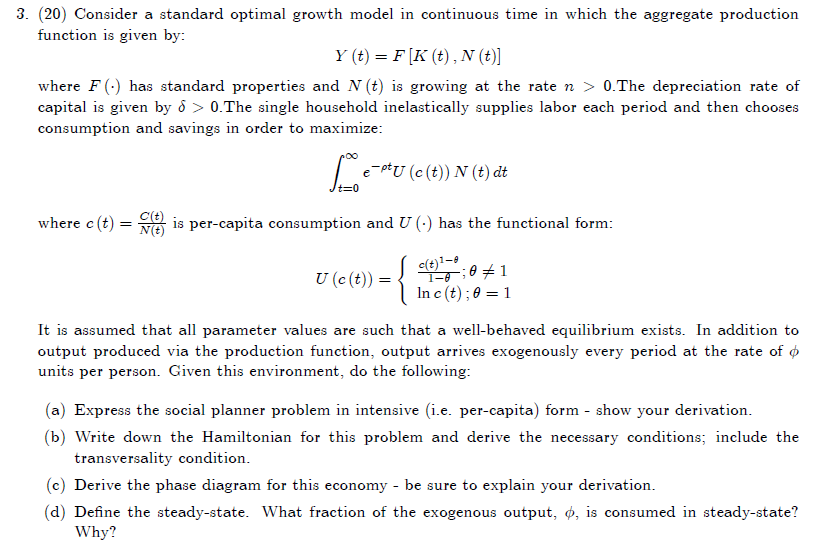
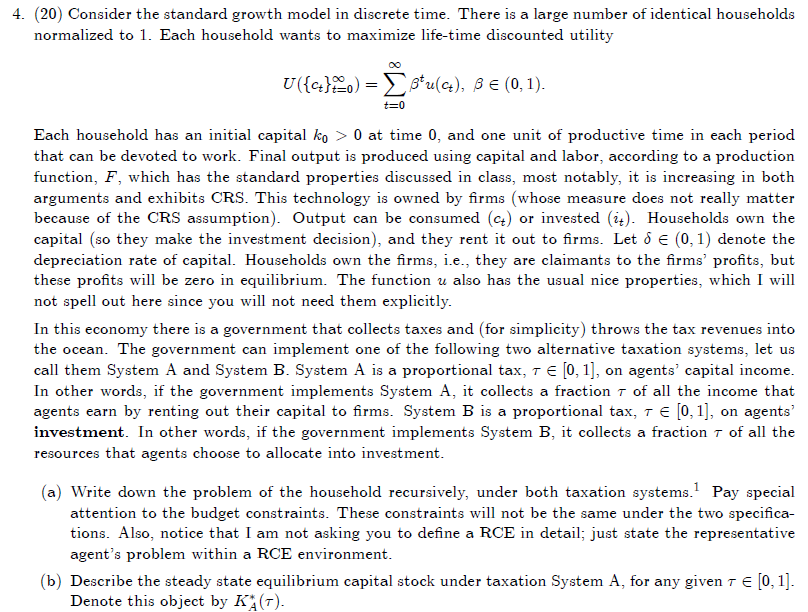
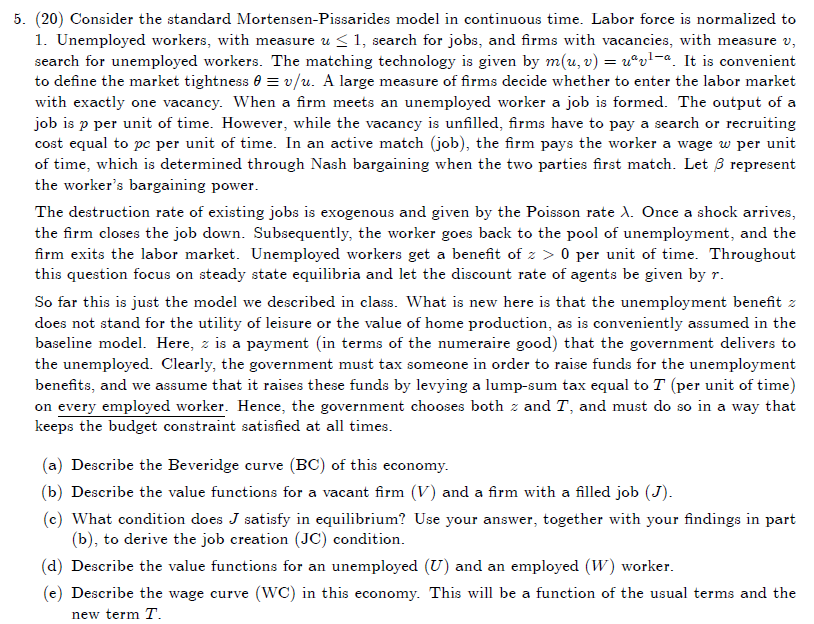
Please answer them. ....its complete
l. (10} Each period. an innitelylived agent divides his endowment of 1 unit of time between human capital production [a nonmarket activity} and work in order to maximize the present discounted value of lifetime earnings. Let It; denote the human capital stock at time t and let 1 lg be time spent working. Income each period is given by by {1 51} m where w is the rental rate of human capital. New human capital {i.e. investment in human capital} is produced via the production function (hilt? ; o: E [[1, 1} . Note that human capital depreciates at the rate 5 and the real interest rate is given by the constantT r. [a] Express the agent's maximization problem as a dynamic programming problem and identify the states and controls. {b} Derive and interpret the Euler equations associated with this problem. [c] Assume that a steadystate exists so that h; = If: and It = If. Solve for these steadystate values. {d} \"What is the impact of the two prices {13;} on the steadystate values? Explain. 2. {2'0} Consider a representative agent economy in which preferences are given by: 1 (3th En (23* [1\"? wish \"3 5&1me i=1) where E denotes the expectations operator and H: is an Lid. random variable which affects the disutility of labor supply. Output in the economy is produced by rms that use labor and an inelastically supplied unit of non depreciating capital [owned by rms you can think of this as land}. The choice of labor is made to maximize prots each period: Erewalls max in yt Iiia: CE 6(011} where y denotes output and w: is the wage. The prots are returned to the households. In addition to labor supply. agents also trade one period bonds [riskfree) that cost 3): at time t and return 1 unit of consumption in period t + 1. Given this environment, do the following: [a] Express the household's problem as a dynamic programming problem and derive the associated necessary conditions. Note that households take as given rm prots. the wage and the price of bonds {i.e. it is a standard competitive economy]. [b] Find the competitive equilibrium allocation by solving the social planner's problem for this economy. [c] Solve for the polic}r functions which describe equilibrium consumption and labor. Provide an expla nation for the implied behavior of these variables. (d) Determine the solution for the equilibrium price of bonds. Explain how the preference shock. Ht, affects the price of bonds- \f4. {20] Consider the standard growth model in discrete time. There is a large number of identical households normalized to 1. Each household wants to maximize lifetime discounted utility UHrslliu} = Ztc, :3 E {'1}: 1}- t=D Each household has an initial capital kg. 2} l} at time 0, and one unit of productive time in each period that can be devoted to work. Final output is produced using capital and labor, according to a production function, F, which has the standard properties discussed in class, most notably, it is increasing in both arguments and exhibits CRS. This technology is owned by rms {whose measure does not really matter because of the CRS assumption}. Output can be consumed {q} or invested {it}. Households own the capital [so they make the investment decision}, and they rent it out to rms. Let 5 E (D, 1} denote the depreciation rate of capital. Households own the rms, i.e., they are claimants to the rms1 prots, but these prots will be zero in equilibrium. The function i: also has the usual nice properties, which I will not spell out here since you will not need them explicitly. In this economy there is a government that collects taxes and [for simplicity} throws the tax revenues into the ocean. The government can implement one of the following two alternative taxation systems, let us call them System A and System B. System A is a proportional tax, T E [I], 1], on agents1 capital income. In other words, if the government implements System A, it collects a fraction 1' of all the income that agents earn by renting out their capital to rms. System B is a proportional tax, T E [l], l], on agentsI investment. In other words, if the government implements System B, it collects a fraction '3' of all the resources that agents choose to allocate into investment. {a} \"'rite down the problem of the household recursively, under both taxation systems.1 Pay special attention to the budget constraints. These constraints will not be the same under the two specica tions. Also, notice that I am not asking you to dene a RUE in detail; just state the representative agent's problem within a RUE environment. {b} Describe the steady state equilibrium capital stock under taxation System A, for any given 1' E ['3, l]. Denote this object by K2,\5. {20} Consider the standard MortensenPissarides model in continuous time. Labor force is normalized to 1. Unemployed workers, with measure a E 1, search for jobs, and rms with vacancies, with measure 1:, search for unemployed workers. The matching technology is given by m{u,v} = trawla. It is convenient to dene the market tightness H E 1.1 {it A large measure of rms decide whether to enter the labor market with exactly one vacancy. \"Then a rm meets an unemployed worker a job is formed. The output of a job is 19 per unit of time. However, while the vacancy is unlled, rms have to pay a search or recruiting cost equal to pa per unit of time. In an active match {job}, the rm pays the worker a wage to per unit of time, which is determined through Nash bargaining when the two parties rst match. Let ,3 represent the worker's bargaining power. The destruction rate of existing jobs is exogenous and given by the Poisson rate )5. Once a shock arrives, the rm closes the job down. Subsequently, the worker goes back to the pool of unemployment, and the rm exits the labor market. Unemployed workers get a benet of z 1} D per unit of time. Throughout this question focus on steady state equilibria and let the discount rate of agents be given by 1". So far this is just the model we described in class. 'What is new here is that the unemployment benet :5 does not stand for the utility of leisure or the value of home production, as is conveniently assumed in the baseline model. Here, 3 is a payment {in terms of the numeraire good} that the government delivers to the unemployed. Clearly, the government must tax someone in order to raise funds for the unemployment benets, and we assume that it raises these funds by levying a lumpsum tax equal to T l[per unit of time} on every employed worker. Hence, the government chooses both 2 and T, and must do so in a way that keeps the budget constraint satised at all times. {a} Describe the Beveridge curve {BC} of this economy. {b} Describe the value functions for a vacant rm {V} and a rm with a lled job {J}. {c} \"'hat condition does J satisfy in equilibrium? Use your answer, together with your ndings in part {b}, to derive the job creation {JG} condition. {d} Describe the value functions for an unemployed {U} and an employed {W} worker. {e} Describe the wage curve [UFO] in this economy. This will be a function of the usual terms and the new term T





